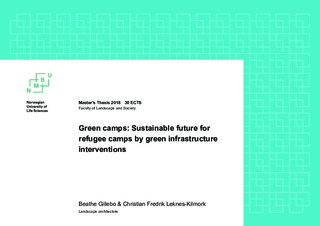| dc.contributor.advisor | Egoz, Shelley | |
| dc.contributor.author | Leknes-Kilmork, Christian Fredrik | |
| dc.contributor.author | Gillebo, Beathe | |
| dc.coverage.spatial | Jordan, Mafraq | nb_NO |
| dc.date.accessioned | 2019-02-26T13:43:38Z | |
| dc.date.available | 2019-02-26T13:43:38Z | |
| dc.date.issued | 2018 | |
| dc.identifier.uri | http://hdl.handle.net/11250/2587549 | |
| dc.description.abstract | With more than 68 million forcibly displaced persons in the world as of 2018 (UNHCR), a response is needed within several professions, also landscape architecture. Although few refugees actually live in refugee camps, but it is these camps that so often catches our attention and imagination. These spaces are a very extreme frame for human habitation.
As landscape architects, we take a look at how a green infrastructure intervention can increase the quality of life for camp dwellers. Green infrastructure is the totality of the natural systems in a place and can be both man-made and naturally grown.
Through a literature review we look at the available knowledge of how green infrastructure affects our lives and health, and what kind of situation refugees are in. Most of the literature on green infrastructure have not been done on refugee populations and not at all on refugee camp populations. Still, we make some assumptions on how green infrastructure can be beneficial for refugees, and how in an extreme situation (as a refugee camp is) it may mitigate and ease the problems facing them. A better quality of life for refugees is a more sustainable future – for the refugees but also for host countries and possible future host countries. A healthier, more robust and resilient refugee population is a more sustainable future for the whole World indeed. | nb_NO |
| dc.language.iso | eng | nb_NO |
| dc.publisher | Norwegian University of Life Sciences, Ås | nb_NO |
| dc.rights | Attribution-NonCommercial-NoDerivatives 4.0 Internasjonal | * |
| dc.rights.uri | http://creativecommons.org/licenses/by-nc-nd/4.0/deed.no | * |
| dc.subject | UNHCR | nb_NO |
| dc.subject | LOGOReP | nb_NO |
| dc.subject | Jordan | nb_NO |
| dc.subject | Planning | nb_NO |
| dc.subject | Social sustainability | nb_NO |
| dc.subject | Green urbanism | nb_NO |
| dc.subject | Public health | nb_NO |
| dc.subject | Syria | nb_NO |
| dc.title | Green camps : sustainable future for refugee camps by green infrastructure interventions | nb_NO |
| dc.type | Master thesis | nb_NO |
| dc.subject.nsi | VDP::Samfunnsvitenskap: 200::Urbanisme og fysisk planlegging: 230::Landskapsplanlegging: 236 | nb_NO |
| dc.subject.nsi | VDP::Samfunnsvitenskap: 200::Urbanisme og fysisk planlegging: 230::Urbanisme: 237 | nb_NO |
| dc.subject.nsi | VDP::Humaniora: 000::Arkitektur og design: 140::Landskapsarkitektur: 147 | nb_NO |
| dc.source.pagenumber | 114 | nb_NO |
| dc.description.localcode | M-LA | nb_NO |

